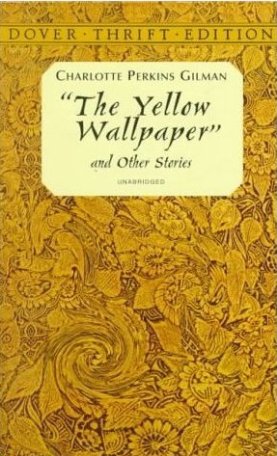“The Yellow Wallpaper” is a short story that was written by Charlotte Perkins Gilman in 1892. This text is considered to be an early piece of feminist literature, and touches on the subject of the mental health of women.
From being trained in my days as an English literature major when I was an undergraduate, I usually read with a pen in my hand. When I started reading, “The Yellow Wallpaper”, I found myself immediately writing questions in the margins. The story opens up with the narrator explaining that her husband is a highly respected physician, who does not believe that she is actually ill. Her brother, who is also a physician, agrees that his sister is just suffering from “temporary nervous depression” (674). This immediately had my mind running with questions, some being:
-What kind of physicians are the narrator’s husband and brother?
-Are they qualified to be diagnosing her with an emotional disorder?
The footnotes in my copy of this text explain that temporary nervous depression is an emotional problem that women were diagnosed with, that stems from anxiety or depression. Nervous women were classified as “hysterical”.
As I continued reading the story, the narrator explains that she disagrees with her diagnosis, and that since she cannot work she likes to write, but that it exhausts her and she has to hide it from her husband, John. As a change of topic, she begins to describe her house that she lives in, which she says is, “the most beautiful place!” (674). As the house is being described, I am able to envision it perfectly… I can see the giant hedges and gates that enclose the property, which I imagine to be tremendous due to the multiple little houses that are for gardeners and such. The garden is described as somewhere magical, but then I learn that there also used to be greenhouses on the property, but now they are broken. After this, the narrator says, “…there is something strange about the house- I can feel it” (674).
Knowing the little bit of information that I know about the narrator at this point, I begin to question what she is saying about a “strangeness” in the house… are her accusations actually reliable being that she is diagnosed with hysteria? Maybe they are, but at this point I really cannot tell. Using different context clues from the text, I am leaning towards my initial thought that the narrator is unreliable. At one point she says that she finds herself getting “unreasonably” mad at her husband; I underlined this line while I was reading. When I went back to it after I first read it, this line stuck out to me because it is not someone else making this accusation, the narrator is saying it about herself.
As the narrator describes the room her husband has her spend her time in, I learn it served as s nursery, a playroom and a gymnasium before she was living there. The room is explained as having chipped paint and patches of hideous wallpaper adorning the walls. As the narrator continues on, I can picture the wallpaper in my head…
“The color is repellant, almost revolting; a smouldering unclean yellow, strangely faded by the slow-turning sunlight. It is a dull yet lurid orange in some places, a sickly sulphur tint in others. No wonder the children hated it! I should hate it myself if I had to live in this room long.” (675).
As much as the narrator seems to despise this wallpaper, later on in the story (after about two weeks of living in the room) she says that she is beginning to develop a true liking for the room, but cannot decide if it is in spite of the yellow paper or because of it. She now uses the wallpaper to entertain herself, she spends hours upon hours following the design of the pattern to see where it leads to.
The vivid descriptions throughout the text so far really allow me to feel like I can picture the room that the narrator is living in. I continue questioning if her fascination with the wallpaper is stemmed from her boredom, or if it has to do with her diagnosis. I also am still unsure of the reliability of the narrator, and hope that in the latter half of the story that I will be able to draw concrete conclusions about this.


Hi Lauren!
This sounds like a very interesting short story! I love how you said that you learned to write with a pen in hand when you were an English Literature major. As I always loved math, reading comprehension was never my strong suit. I wonder if my steps would be similar to yours as I read. I like how you write questions in the margin and picture what is happening in the story. After learning all of the new techniques to do while reading, I hope to see that my reading comprehension improves. I find myself often rereading stories, as I get confused or lost often while reading literature. I think you have great techniques and I cant wait to hear more!
Christina